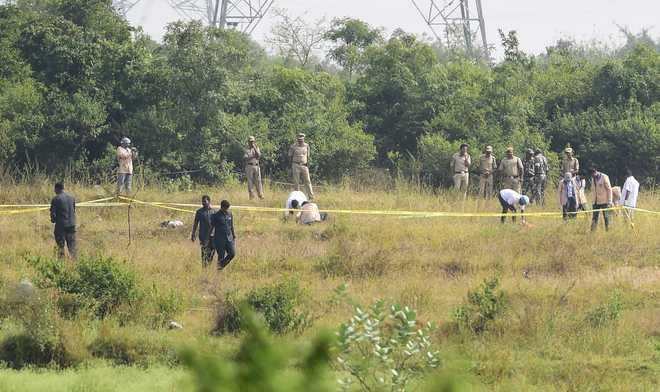The 2019 Hyderabad Encounter and Dark Periphery of Police Power

Representational Image. Image Courtesy: Tribune India
On 6 December 2019, four people accused of raping and killing a veterinary doctor were shot dead in a police encounter in Hyderabad, Telangana. A Supreme Court-appointed commission looking into the case has recently concluded that they were “deliberately fired upon”. The commission has called it an extrajudicial killing. There is no clear-cut definition of “extrajudicial” killing in India. The hyphenated term “extra” indicates that specific ‘encounters’ or killings do not fall within the legal steps judicial activities require. However, we rarely note that such killings contribute to dismantling the ideological basis on which law and order are sustained in India—the promise of justice and democratic equality.
India’s legal system assures every individual, regardless of identity, a trial before being labelled as guilty of a criminal act. Without a trial in a court of law, the guilt or innocence of an accused person cannot be legally established. In the Hyderabad case, ten policemen shot dead four people—three minors and an adult male, according to the commission—after taking them to an isolated spot. Hence, we find that there are legal provisions to protect the fundamental human rights of every Indian citizen, but extrajudicial killings regularly undermine these rights along with the legal system.
What exactly is the problem?
News of the Hyderabad encounter was widely welcomed across India. Within hours, many people gathered at the site of the killing to distribute sweets and set off firecrackers. People also fired off approximately three lakh tweets with hashtags supporting Hyderabad Police. Those who supported the shooting brutally trolled, condemned and attacked those who were calling out the incident as an execution of suspects without a fair trial. Some pointed out that the police had been “wrongly trigger-happy”, but others quickly portrayed the police as Singham-style cops. Those glorifying extrajudicial proceedings generated a craze, almost as if it was a Bollywood movie.
After strong protests from human rights activists, the Supreme Court set up the Justice VS Sirpurkar Commission to investigate the killing of the four men. Its 387-page detailed findings include that the encounter was fake and the accused were murdered, and the ten policemen involved need to be tried for the crime. The commission has raised a barrage of questions: were there eye-witnesses other than the police officers involved, were police manuals followed, had senior police officers issued any warnings to them, why was the FIR against the four suspects lodged after the encounter, and only then were they tagged as accused in the rape and murder case? Further, the commission has asked what injuries (major or minor) the police personnel suffered in the alleged brawl with the suspects, and why the Telangana government did not initiate any judicial inquiry into the case, as the law mandates.
The police claimed that the four accused were trying to snatch their weapons, which is the only reason given for why they all had to be shot. However, the commission said that no (used) bullets or cartridges were found from the encounter site. Furthermore, the police produced incomplete video footage of the shooting.
It is a matter of grave concern whether the police arrested the men they believed responsible for the crime or simply picked up four people at random to quell public outrage over the murder and rape of a young professional. Based on this point, the commission has recommended that the ten police personnel involved in the case must be prosecuted. It has found them guilty of destroying and withholding evidence.
The commission has shed light on other critical aspects of this case that contradict the police version, such as CCTV footage, safety latches on weapons, how far the accused were from the police during the firing, fingerprints on the guns and the timing of their release from prison, and much more.
Yet, the commission lacks findings related to the usual modus operandi that police adopt in ‘fake’ encounters. Had it done so, we would have known the exact motives of the cops behind staging the encounter. Rapes and murders have among the lowest conviction rates, the National Crime Records Bureau data revealed in 2021. Usually, the police feel helpless when the legal process is long drawn out, even when cases relate to grievous crimes. Others may hold the view that the accused escape punishment due to lacunae in investigation and prosecution. However, is resorting to encounters a solution for these problems? Obviously not. Instead, the police must undertake a systematic investigation to prove the arrested person is indeed the guilty one.
There have been numerous instances of encounters in Maharashtra, Uttar Pradesh and Punjab, other than the killings of Naxalites and dreaded criminals in custody. There may be much to condemn in the acts of such groups or people, but this cannot justify killing people in custody. Police custody is a dark periphery where members of the force exercise the ultimate power. This darkness is the point where most encounters get planned and executed. According to retired justice Markandey Katju, “...encounters are not clashes at all rather all of them are cold-blooded murders”. The Supreme Court observed in Prakash Kadam vs Ramprasad Vishwanath Gupta, “...where a fake encounter is proved against policemen in a trial, they must be given death sentence, treating it as the rarest of rare cases.” In the same case, the court said, “Trigger-happy policemen who think they can kill people in the name of ‘encounter’ and get away with it should know that the gallows await them.”
India can only end the commission of crimes by police when an arrested suspect or accused gets judicial custody from day one and police custody is wholly denied. To deter such encounter killings, we must change the way the police behave.
Article 21 of the Constitution says, “No person will be deprived of his life or personal liberty except with the procedure established by law.” In other words, only a court of law can deliver justice. India has an independent judiciary to deal exclusively with judicial matters. The task of the police is to carry out investigations, not satiate public sentiments with abrupt and haphazard deeds. If the police become judges, who will do the work assigned to them? Justice is possible only if the police help the victims of crime, identify suspects, and corroborate their narrative with a competent and robust investigation.
The Sirpurkar Commission has strengthened people’s faith in the impartial and rational decision-making capacity of the Supreme Court. Let the justice system now punish all who participate in state-sponsored killings. Each extrajudicial act of the police must be checked for justice to prevail.
The author is an assistant professor at the University of Delhi. The views are personal.
Get the latest reports & analysis with people's perspective on Protests, movements & deep analytical videos, discussions of the current affairs in your Telegram app. Subscribe to NewsClick's Telegram channel & get Real-Time updates on stories, as they get published on our website.
























